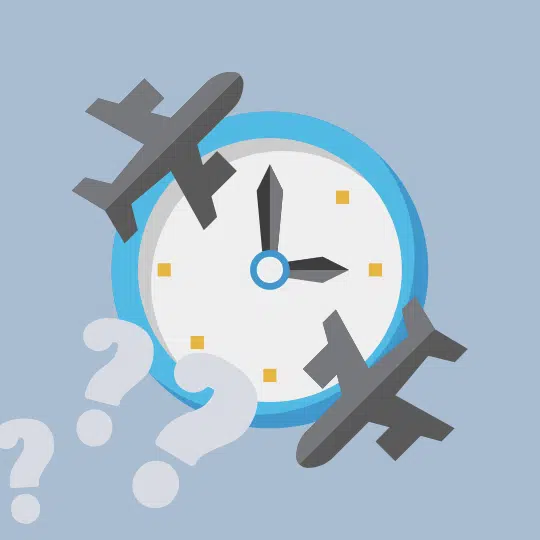How to Combat Jet Lag
While traveling internationally is amazing for too many reasons to list, there’s one big downside to visiting a lot of destinations: jet lag. Your brain may want to explore, but your body may be begging for sleep or you’re wide awake in the middle of the night. Though the severity of jet lag depends on how far you’ve traveled, there’s always ways for you to lessen the effects.
This post may contain affiliate links, which means I’ll receive a commission if you purchase through my link, at no extra cost to you.
Preparing In Advance
The best defense for jet lag is a good offense. Here’s what you can do before you arrive at your destination to set yourself up for success.
Your Plane Can Make a Difference
The battle against jet lag actually begins as early as the day you pick your flight. There are actually 2 types of planes that have been designed to help combat jet lag: the Airbus A350 and the Boeing 787 Dreamliner. They have a lower cabin pressure set to an altitude of 6,000 feet compared to the 8,000 feet other planes use which helps your body feel more like it’s on the ground. They also have other features built in that help reduce turbulence and noise so you can sleep better in the air, which is especially helpful on red eye flights.

You can still be successful at minimizing jet lag without these planes, so don’t feel despair if you can’t book one (or if the airline does a last-minute tail swap to another type of aircraft).
Come Prepared
For long flights, I always pack items in my carry on to help me sleep and adjust to my new time zone. Here are my three go-tos:
Compression Socks
Studies have shown that compression socks can help combat jet lag because they increase circulation and keep blood from pooling in your feet (because gravity). Comrad makes some not-completely-ugly compression socks that I just slip on after takeoff. Getting up and moving on the flight can also help circulation, but compression socks are great when you want to prioritize sleep.
Eye Mask
Eye masks are usually included in the amenity kit when you fly in a premium cabin, but for everyone else, it’s a good idea to bring your own. It’s an inexpensive way to help sleep better when the cabin lights are on or your neighbor is using their reading light.
Homeopathic Jet Lag Tablets
I’ve used these homeopathic jet lag tablets on several trips and maybe it’s just the placebo effect, but I think it helps in the fight against jet lag. You take one tablet after takeoff and then another every 2 hours (but I skip it if I’m sleeping).
Stay Hydrated
This one is a bit of “do as I say not as I do.” On long flights I’m notorious for dehydrating myself so I don’t have to pee (especially because I like the window seat to rest against the wall on a red eye). Staying hydrated is really important to help your body function at its best and the air on planes is very dry and dehydrating, only compounding the issue.
I always make sure to bring my own bottle and fill it up after I go through security. Flight attendants don’t come around nearly enough with drinks and the 6 oz of water they give you every 3 hours isn’t ideal. I love this fold up water bottle that packs small when empty:
Avoiding both alcohol and caffeine will help keep you hydrated and make the adjustment easier. Caffeine will not only keep you awake but it’s a diuretic that dehydrates you (so is alcohol). The free alcoholic drinks are tempting but they won’t pay off in the long run. Also save the coffee for after you land – airlines are notorious for seldom cleaning their coffee pots, so best to avoid that anyways.
[RELATED: How to survive a red eye in economy]
Combat Jet Lag Upon Landing
Stay on Your Destination’s Time
If you’re landing at 9AM in your destination, you’re going to want to do everything you can to stay awake all day. I don’t even nap the day I arrive! Red eye time adjustments are usually much more difficult than landing in the evening and having to fall asleep shortly after arrival.
If you’re arriving in the morning, here’s what you should consider:
Be Generous with Caffeine

Coffee is my first stop after a red eye flight and I don’t hesitate to get 2-3 cups to throughout the day to make it all the way to sunset.
Get Sunlight & Move Your Body
Getting outside and walking around is absolutely critical for me to stick the landing on the time change. Earlier this year, we arrived in Dublin after a red eye flight and were stuck in a dark hotel room working remotely for the rest of the day. That was the worst jet lag I’ve ever had coming over to Europe.
Usually, we don’t have to work the day we arrive and hit the ground running with sight-seeing. Sunlight not only gives you the vitamin D your body needs but also helps keep your brain from releasing the melatonin that wants to drag you off to dreamland.
For Evening Arrivals
If you do arrive really late, you’ll want to take opposite measures than a morning arrival. Try to stay awake on the flight so you’re tired upon arrival. Taking a sleep aid like ZzzQuil can also help you go to sleep at the appropriate time.
FINAL THOUGHTS On Combatting Jet Lag
To an extent, jet lag is an inevitability of travel. However, there’s a lot you can do to set yourself up for success. Don’t just resign yourself to being miserable when you arrive!
If you’ve tried all of these methods in the past and still find yourself struggling, build in an extra day at the start of your trips to adjust. As someone who likes to maximize every second on a trip, this is a last resort, but it could make the experience more pleasant for you.
You may also like:

